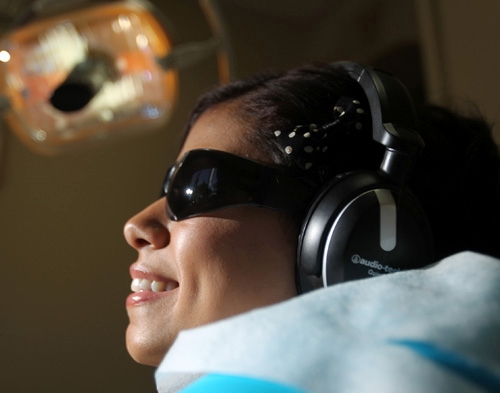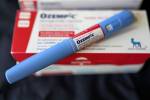Advances in pain management help patients overcome fear of dentist
Patty Peterson considers herself someone who has "a pretty high pain threshold."
Yet for most of her life, Peterson, 54, went to the dentist only as a last resort.
"I'd wait until something hurt, and then I'd go," she says.
She recalls nothing in particular that led to her longtime pattern of dental avoidance, "other than for the time they tried to give me an injection in the middle of the roof of my mouth. I remember that. I really wanted to punch the dentist."
Then, about two years ago, she became a patient of Dr. Peter Balle and is amazed at how, well, not painful her dental experiences have been since. That, she adds, is true even for such significant work as the placing of tooth implants.
"They give you drugs when you go in there. Someone has to drive you," she says. "And you don't really remember anything at all. You walk around and you talk to people, but you don't remember anything.
"Which," Peterson adds with a laugh, "is good and bad. Then you just come home and sleep a couple of hours."
It's a scenario longtime dental avoiders would find amazing. It's also evidence that, while dentistry probably never can be guaranteed to be -- as those signs in old Westerns claimed -- painless, it can be made way less painful than it was just a decade or three ago.
Of course, pain is a relative thing. Dr. Daniel Orr, director of oral and maxillofacial surgery at the University of Nevada, Las Vegas School of Dental Medicine, has performed oral surgery on patients who "ask for nothing -- no local or anything, and pretty much rely on self-hypnosis and do just fine."
At the other end of the perceived pain spectrum, Orr says, are "patients who want to be put to sleep for the X-ray. You just never know."
The costs of ignoring dental treatment for fear of pain can be high. Balle has known patients who have curtailed social activities -- or avoided dining out or feared kissing a spouse -- because of long-neglected dental problems.
"It can really have an impact on quality of life," he says.
For some, a fear of going to a dentist began when they were younger and dental pain-management techniques weren't as sophisticated as they are today. Balle says he often hears dental avoiders say, "I went to the dentist when I was a kid and he never gave me anesthesia."
"It does seem I've gotten people who were born in the '40s and '50s who say that. I don't see as many young people who are that way."
Yet it's dentists who long have been on the front lines of anesthesia. Orr notes that it was American dentistry that "introduced general anesthesia to the world in December 1844."
And, for that, credit Dr. Horace Wells, a Hartford, Conn., dentist who saw the effects of nitrous oxide -- laughing gas -- demonstrated at a public performance.
"It was like a carnival-type thing," Orr says. "People would go up on stage and laugh, and it would be a good time for everybody."
A man whom Wells knew was one of the participants at the show. When the man injured his leg coming off of the stage, "he woke up with blood all over his leg and didn't know what happened. So Horace Wells thought, 'Hey, I wonder if I could take a tooth out with this stuff.' "
It turns out he could, with Wells, himself, serving as the guinea pig. The story turns both weird and depressing after that -- public failure, suicide, a nasty battle for credit -- but Wells today is, Orr notes, recognized by the American Dental Association, American Medical Association "and throughout the world as the person who introduced safe, reproducible general anesthesia to the world. So dentistry started it all."
More anesthetic agents followed, all adopted with the end of making dental procedures less painful.
Most patients are familiar with nitrous oxide and Septocaine (often incorrectly referred to as Novocaine). They're local anesthetics that are common and create a condition called light sedation, in which the patient remains awake and communicative.
This category of light sedation also can include such oral medications as Valium, which, taken in oral or intravenous form, "relaxes patients a little bit," Orr says. "The patient is awake and communicates well."
Properly administered, the anesthetic agents used in light sedation are "extremely safe," Orr says. "The incidence of mortality in a dentist's office is second to none, about 1 in 700-plus-thousand. That's extremely good compared to any other (surgical) venue."
Light sedation agents also can be administered by any licensed dentist, Orr says. However, creating deeper levels of sedation in patients requires dentists to obtain specialized training and hold additional certifications from the state.
Then, in moderate sedation, drugs are administered, often intravenously but also orally, that leave a patient able to respond to touch and communicate, although the sedation will be "at a deeper level," Orr says.
In what is called deep sedation, which usually is created through the use of intravenous drugs, patients are asleep and require monitoring.
Finally, for an even deeper level of sedation, dentists may opt for general anesthesia, in which patients are completely asleep and don't respond to pain. However, patients under general anesthesia must be watched constantly, because the anesthetic agents that are used may, for example, prevent the patient from breathing on his or her own, Orr says.
Choosing a proper level of dental sedation hinges on several things, including the procedure being done, the patient's medical history -- for instance, Propofol, the anesthetic linked to Michael Jackson's death, shouldn't be administered to someone who's allergic to eggs, Orr says -- and, even, the patient's mindset.
"Some patients, even if they're moderately sedated, their subconscious will still be scared to death. They may be wriggling or crying, and it's hard to do surgery, so you'll have to take them to a deeper level," Orr says. "You just never know how people are going to respond."
Orr recommends that patients who are considering sedation dentistry ask their dentists whether they have a license from the state to do so. Then, he says, "you might want to ask him about his training and ask him how many he's done. Have they done four or five or four- or five-thousand?"
Do today's sophisticated anesthetics mean truly painless dentistry? Probably not, Balle says, and dentists may leave themselves open to state board disciplinary action for making the claim.
But dental anesthesia "has come a long way," he adds. "I'd say the majority of people are not uncomfortable while they're being treated, if you have a knowledgeable dentist and if he gives you adequate anesthesia."
In Balle's office, tools and techniques even are augmented by the effort to create a relaxing, stress-reducing environment. For example, patients may put on sound-canceling earphones and listen to music to drown out the hum and whine of equipment, and put on dark glasses to block out the examination light.
A patient's perception of pain isn't always about pain alone, Balle notes. "It's the loss of control, it's a fear of loss, or a fear of close spaces."
Or, even, how much a patient trusts his or her dentist. Peterson says she has come to have "trust in (Balle's) abilities," and that this, too, helps to keep dental anxiety at bay.
Peterson says she no longer fears dental visits. Does she like going to the dentist now?
"I mean, come on," she answers. "I have a life to live, know what I mean?
"But I don't dread it. It's just part of the things I've got to do."
Contact reporter John Przybys at
jprzybys@reviewjournal.com or 702-383-0280.



























